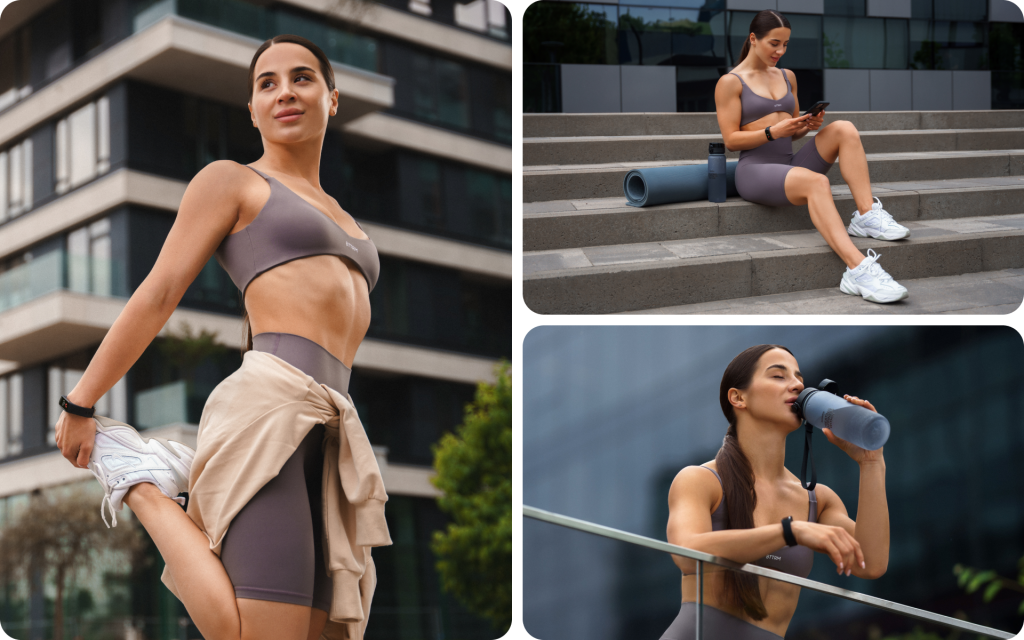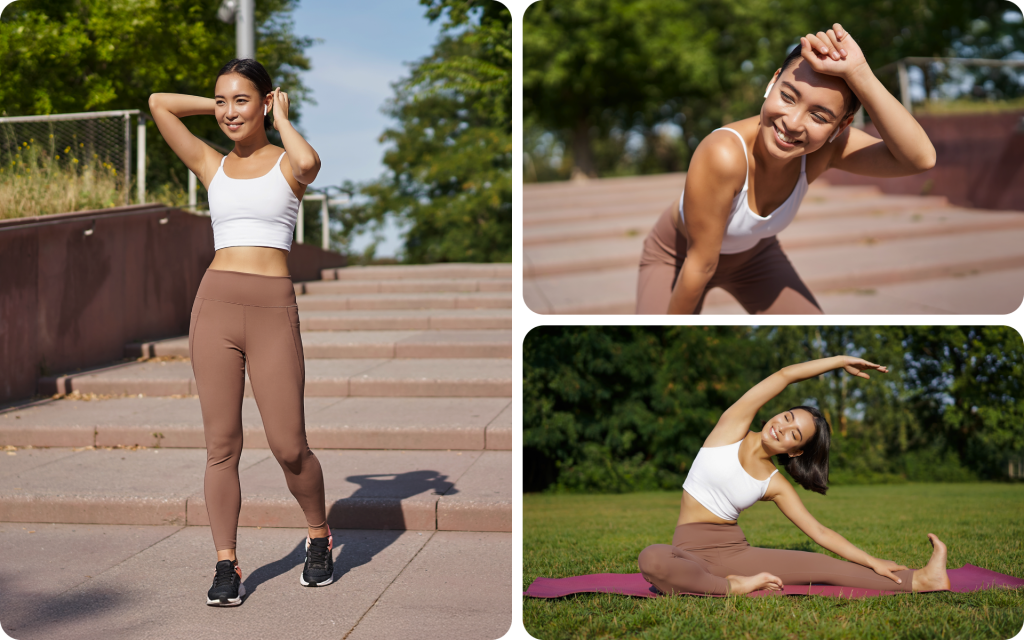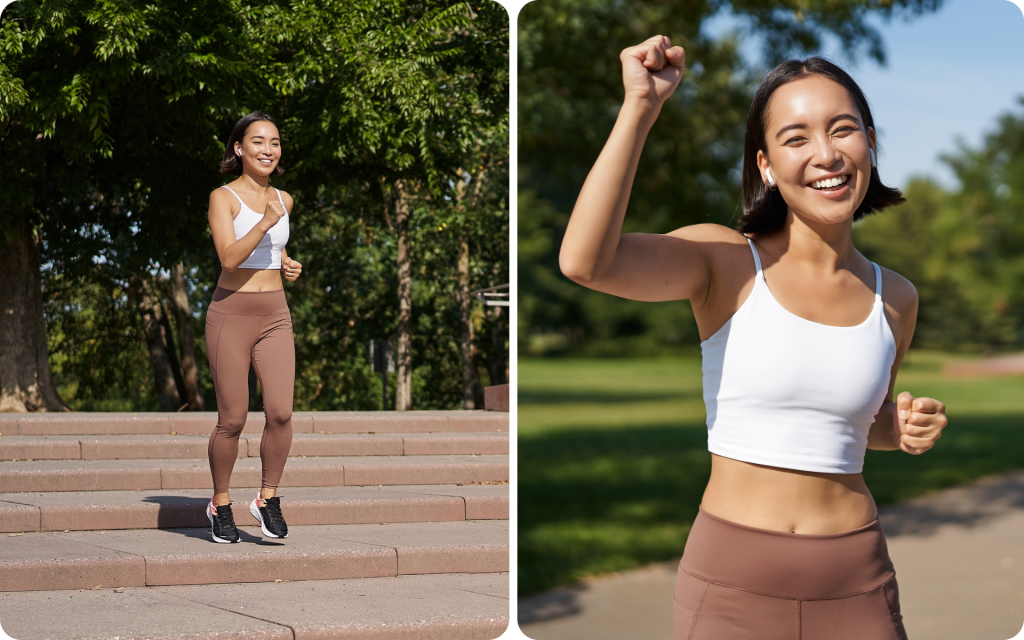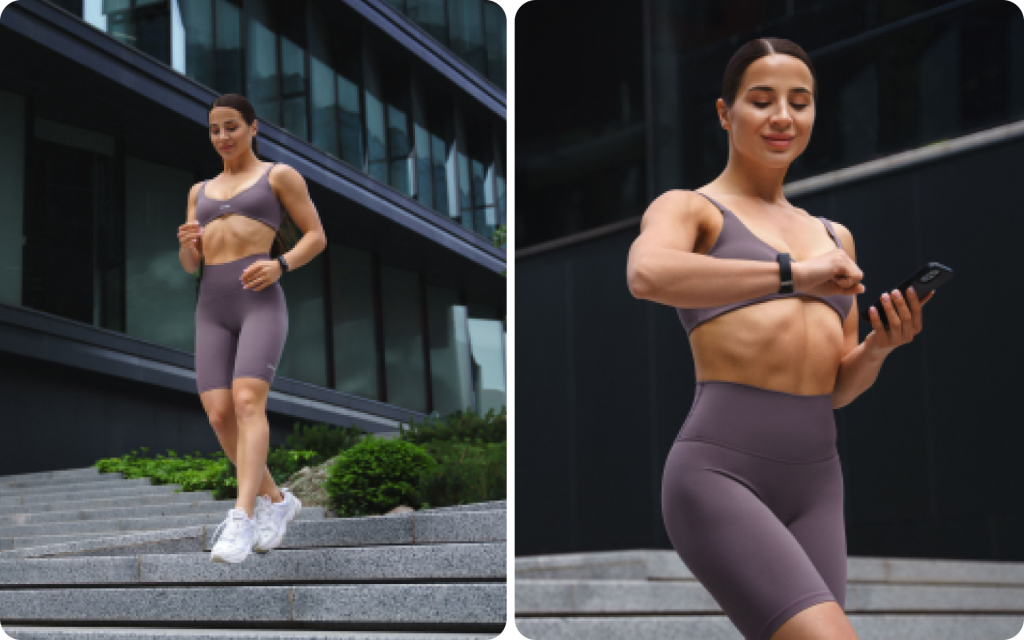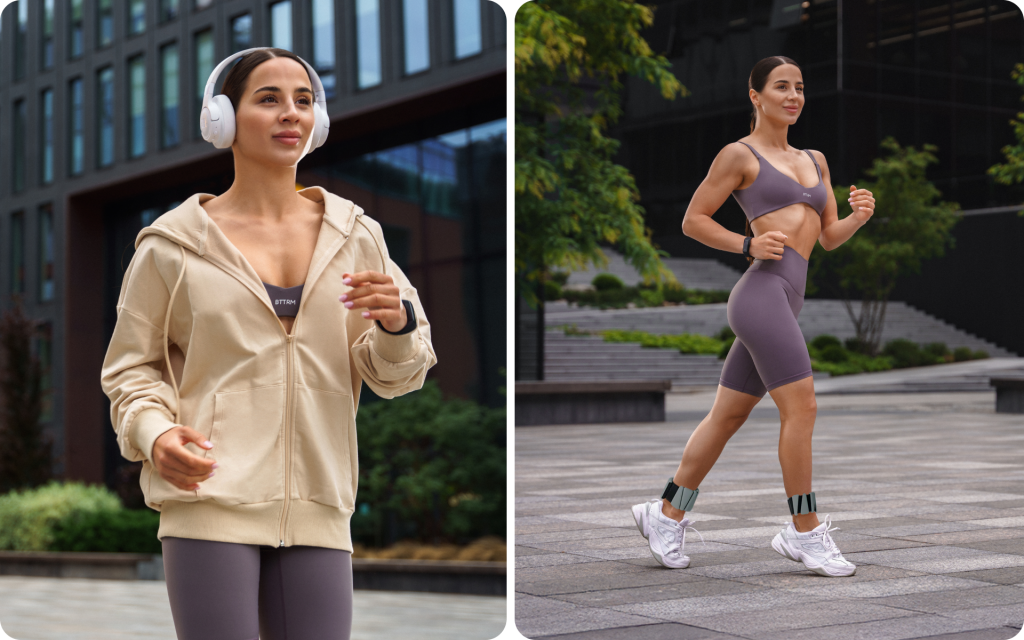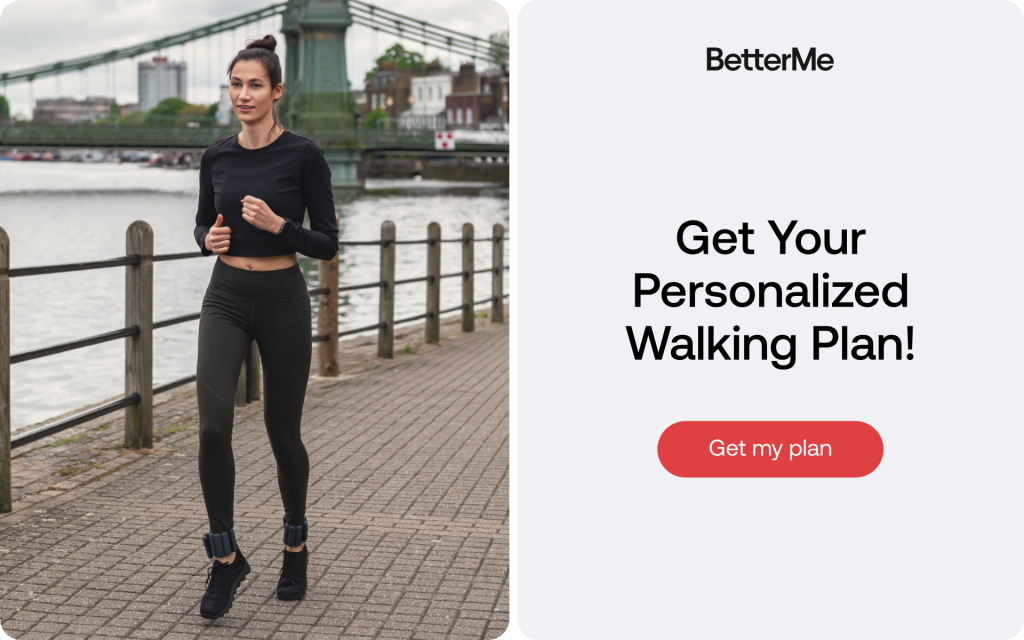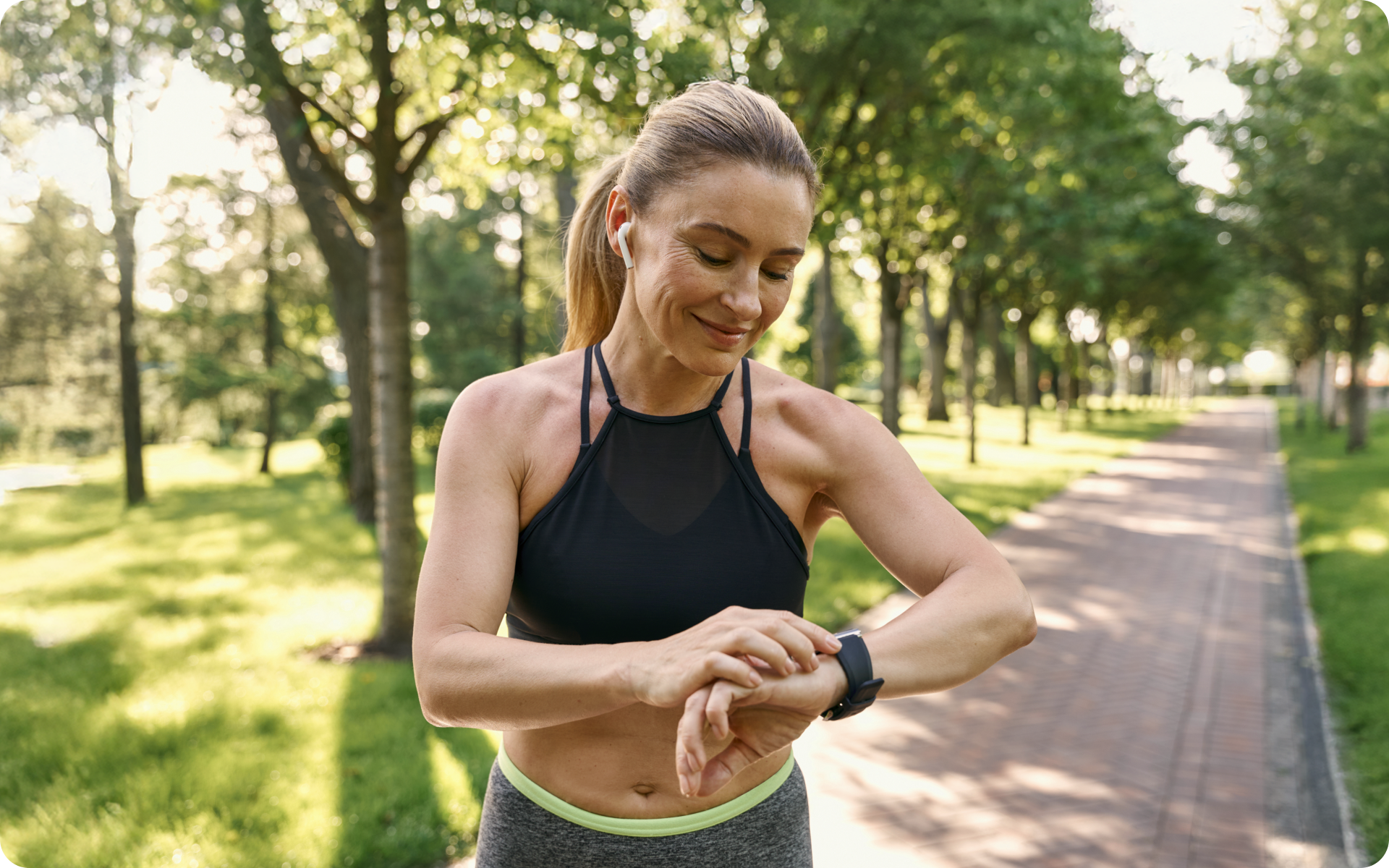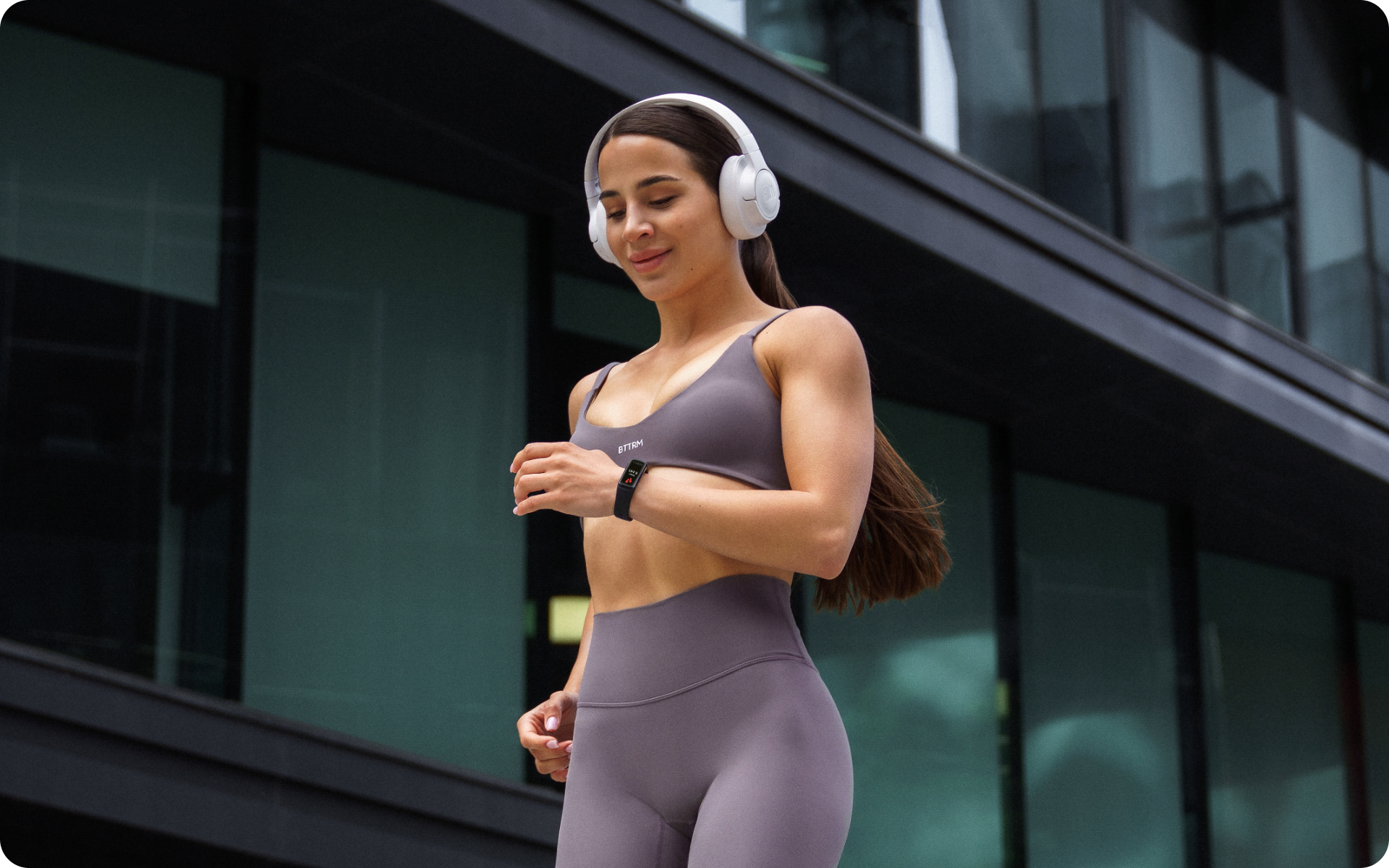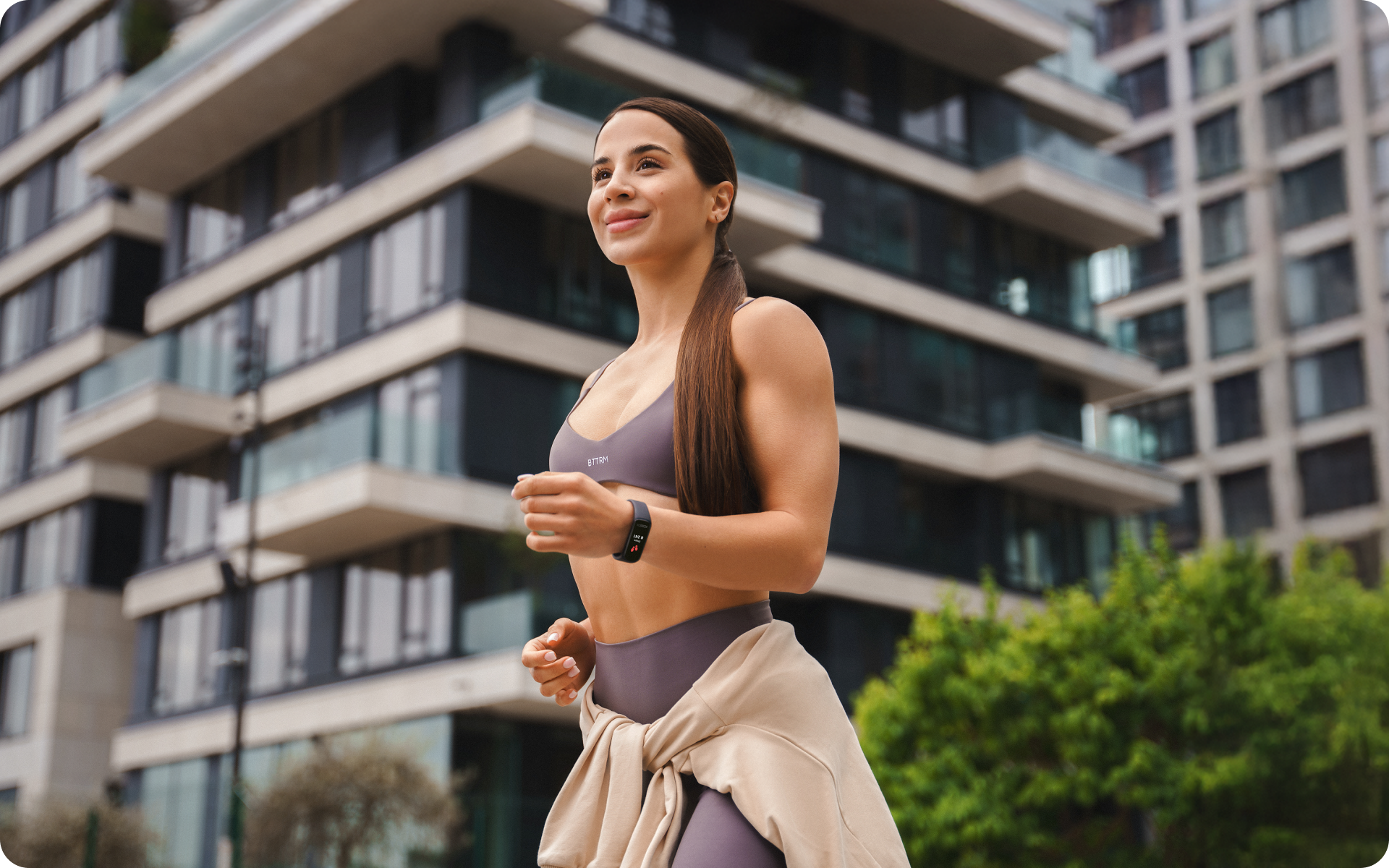Walking might seem too simple to deliver real results. Many people question whether something so basic can meaningfully support their fitness and everyday well-being. The research tells a different story—one that might surprise you.
Read ahead to learn what current research shows about walking, why structured plans often work better than random activity, and how BetterMe’s approach can fit into your wellness journey.
Is Walking All It’s Cracked Up to Be?
Walking stands as one of the most researched forms of exercise, with decades of scientific evidence supporting its wellness benefits. The data consistently shows that regular walking delivers measurable improvements across multiple well-being markers.
- Cardiovascular -Related Markers
A comprehensive meta-analysis of 32 randomized controlled trials found that walking programs significantly improved aerobic capacity while promoting cardiovascular wellness and reducing body mass index (1). The cardiovascular benefits become particularly pronounced when walking reaches moderate intensity levels—approximately 2.5 to 4.2 mph (2).
Research from Harvard’s Physicians’ Health Study demonstrated that participants who walked regularly have better cardiovascular-related markers compared to sedentary individuals. The greatest benefits appeared in those maintaining a “brisk” pace of 3 mph or faster, though even “normal” pace walking at 2.0-2.9 mph provided protective benefits (3).
- Energy Use & Glucose-Related Markers
Walking’s impact goes beyond calorie burn.. Being more active can influence how the body uses and stores energy, and studies report changes in glucose-related markers for some individuals (5).
Research shows that longer walking durations and higher intensity efforts, such as brisk walking or stair climbing, produce greater improvements in glucose responses than casual strolling (6, 7). However, even brief walking breaks—3-5 minutes every 30 minutes—can be associated with favorable short-term glucose responses l in overweight individuals (8).
The American Diabetes Association (ADA) recommends a minimum 150 minutes weekly of moderate-to-vigorous walking, spread across at least three days with no more than two consecutive rest days (9).
Studies demonstrate overall fitness benefits when combining regular walking with resistance training sessions (10).
BetterMe: Health Coaching app helps you achieve your body goals with ease and efficiency by helping to choose proper meal plans and effective workouts. Start using our app and you will see good results in a short time.
- Weight Management and Body Composition
A meta-analysis of 22 randomized controlled trials revealed that brisk walking for approximately three hours weekly produced significant reductions in body weight, body mass index, waist circumference, and fat mass in adults under 50 with obesity (11). The key factor was consistency rather than extreme intensity.
Walking’s effectiveness for weight management stems from its sustainability. Unlike high-intensity workouts that may lead to burnout or injury, walking can be maintained long-term without excessive physical stress.
- Sleep Quality Improvements
Research involving 490 healthy adults found that a four-week walking intervention of 10,000 daily steps significantly improved sleep quality, duration, and latency (time to fall asleep) in previously sedentary participants. Regular exercisers showed improvements primarily in sleep quality, suggesting walking benefits extend across fitness levels (12).
- Mental Wellness and Cognitive Function
Walking demonstrates consistent positive effects on mental wellness , with the strongest evidence supporting depression reduction. Walking is frequently linked with better mood, perceived stress management, and feelings of well-being in natural environments like forests or parks (13).
The mental health benefits appear related to both the physical activity itself and environmental factors. Walking in nature consistently shows superior mental health outcomes compared to indoor or urban walking environments (14).
- Mortality Risk Reduction
A comprehensive meta-analysis of 196 prospective cohort studies involving over 30 million adults examined exercise’s impact on early death risk. Participants meeting minimum guidelines of 150 weekly minutes of moderate exercise showed to lower risk of premature death compared to sedentary individuals (15).
Remarkably, even half that amount—75 minutes weekly or roughly 11 minutes daily—provided 23% lower death risk (15). This translates to activities like parking farther from destinations or taking longer routes to buildings.
Read more: Is There a Walking Workout That’s More Powerful Than Jogging?
Do You Need a Walking Plan?
Random walking provides benefits, but structured plans can help many people be more consistent and progress more predictably. The difference lies in habit formation principles and progressive overload concepts that optimize your body’s adaptation to exercise.
The Science of Habit Formation
Neuroscience research reveals that habits form through consistent repetition in stable contexts (16). When you follow a structured walking plan, you’re essentially rewiring your brain’s neural pathways to make walking automatic rather than requiring constant willpower.
The basal ganglia, your brain’s habit center, strengthens connections when behaviors occur consistently in similar circumstances (16). A structured plan provides the framework for this neural rewiring to occur efficiently.
Progressive Overload in Walking
Athletic training principles apply to walking just as they do to strength training. Progressive overload—gradually increasing training demands over time—ensures continued adaptation and improvement rather than fitness plateaus (17).
A structured walking plan systematically increases variables like duration, intensity, frequency, or terrain difficulty. This progression challenges your cardiovascular system, muscles, and metabolic pathways to adapt continuously.
Accountability and Tracking Benefits
Structured plans provide built-in accountability mechanisms that random walking lacks. When you commit to specific weekly targets, you’re more likely to maintain consistency even when motivation fluctuates.
Research demonstrates that people who track their activity achieve significantly better outcomes than those who exercise without measurement (18). Structured plans inherently include tracking components that enhance adherence and results.
Goal Setting and Achievement
Effective walking plans incorporate specific, measurable, achievable, relevant, and time-bound (SMART) goals that provide clear direction and motivation. Random walking lacks these psychological drivers that sustain long-term behavior change.
Having predetermined milestones creates positive feedback loops that reinforce the walking habit. Each achieved goal builds confidence and motivation for continued progress.
What’s the BetterMe Walking Plan?
The BetterMe walking plan transforms walking from casual activity into structured fitness programming. The platform combines evidence-based exercise principles with user-friendly technology to create personalized walking experiences.
Core Features and Benefits
Customized Programming: BetterMe creates customized walking plans based on current fitness level, goals, time availability, and personal preferences. This customization ensures appropriate challenge levels that promote progress without overwhelming beginners.
Progressive Structure: Plans systematically increase walking demands over time through longer durations, higher intensities, varied terrains, or increased frequency. This progression prevents plateaus and ensures continuous improvement.
Indoor and Outdoor Options: The BetterMe indoor walking plan accommodates weather constraints, space limitations, or safety concerns while maintaining workout effectiveness. Indoor routines include bodyweight movements, marching variations, and interval training that can be performed in small spaces.
Real-Time Guidance: Interactive coaching provides walking technique tips, motivation during workouts, and form corrections to maximize benefits while minimizing injury risk.
Progress Tracking: Built-in monitoring tracks steps, distance, duration, calories burned, and other metrics that provide objective feedback on improvement over time.
The BetterMe 28-Day Walking Challenge
The 28-day format leverages habit formation research showing that consistent behaviors typically become automatic within 21-66 days, with 28 days representing an optimal middle ground for most individuals.
Week 1-2: Foundation Building
- Establish consistent walking times
- Build basic endurance capacity
- Learn proper walking technique
- Create supportive daily routines
Week 3-4: Intensity Integration
- Introduce interval training concepts
- Increase walking duration gradually
- Add terrain or incline variations
- Strengthen habit maintenance strategies
Reasons why BetterMe is a safe bet: a wide range of calorie-blasting workouts, finger-licking recipes, 24/7 support, challenges that’ll keep you on your best game, and that just scratches the surface! Start using our app and watch the magic happen.
Benefits of Time-Bound Challenges
Time-limited challenges create psychological urgency that enhances motivation and compliance (19). The finite commitment feels manageable while being long enough to establish lasting habits.
Research indicates that people are more likely to start and complete fitness programs with clear end dates rather than open-ended commitments (20). The 28-day structure provides sufficient time for meaningful results while maintaining psychological engagement.
Community and Social Support
Challenge formats naturally create communities of participants sharing similar goals and timelines. This social component enhances accountability and provides motivational support during difficult periods.
Studies consistently show that social support significantly improves exercise adherence and long-term behavior change success rates (21).
How to Get Started
Beginning your BetterMe walking plan involves several straightforward steps that set you up for long-term success.
- Initial Assessment and Goal Setting
Start by taking BetterMe’s customizedquiz, which evaluates your current activity level, time availability, and specific objectives. This assessment ensures your walking plan matches your capabilities and aspirations.
Be honest about your starting point. Overestimating current fitness levels leads to overly aggressive plans that increase injury risk and decrease adherence likelihood.
- Equipment and Preparation
Proper Footwear: Invest in supportive walking shoes with flexible soles and adequate arch support. Choose shoes at least a half-size larger than your regular footwear to accommodate foot swelling during exercise.
Comfortable Clothing: Select moisture-wicking fabrics that allow free movement. Layer clothing for temperature regulation, particularly for outdoor walking.
Safety Accessories: Consider reflective gear for low-light conditions, sunglasses and hats for sun protection, and a phone for emergency situations.
- Creating Your Walking Environment
Indoor Setup: Clear a walking path in your home, ensure adequate ventilation, and have water readily available. Consider entertainment options like music or podcasts to maintain engagement during longer sessions.
Outdoor Route Planning: Identify several walking routes of varying lengths and difficulty levels. Having options prevents boredom and accommodates different daily circumstances.
- Building Supporting Habits
Schedule Consistency: Choose specific times for walking and treat these appointments as non-negotiable commitments. Morning walks often show higher adherence rates due to fewer daily distractions.
Preparation Rituals: Lay out walking clothes the night before, prepare water bottles in advance, and charge any tracking devices to eliminate friction between intention and action.
Recovery Planning: Include rest days in your schedule and plan active recovery activities like gentle stretching or light household tasks on non-walking days.
Read more: How Many Steps a Day to Lose Weight?
What to Expect
Starting a structured walking program brings both positive adaptations and temporary challenges that are important to understand and prepare for.
Positive Changes You’ll Experience
Week 1-2: Initial Adaptations
- Increased energy levels throughout the day
- Improved sleep quality and faster sleep onset
- Enhanced mood and reduced stress levels
- Improved daily rhythm and routine
Week 3-4: Fitness Improvements
- Noticeable increases in walking endurance
- Reduced fatigue during daily activities
- Improved balance and coordination
- Stronger leg and core muscles
Month 2 and Beyond: Long-Term Benefits
- ardiovascular support
- Sustainable weight management results
- Better daily stress management
- Established automatic walking habits
Temporary Challenges to Anticipate
Physical Adjustments
- Mild muscle soreness in legs and feet during the first week
- Temporary fatigue as your body adapts to increased activity
- Possible minor joint stiffness, particularly in the morning
Motivational Fluctuations
- Initial enthusiasm may decrease after 1-2 weeks
- Weather or schedule disruptions may test commitment
- Progress may feel slow during certain periods
Time Management Issues
- Finding consistent time slots may require schedule adjustments
- Balancing walking with other responsibilities takes practice
- Travel or unusual circumstances may disrupt routines
How BetterMe Provides Support
Adaptive Programming: The app adjusts workout intensity based on your progress and feedback, ensuring appropriate challenge levels without overwhelming you.
Motivational Tools: Built-in reminders, achievement badges, and progress celebrations maintain engagement during motivational low points.
Educational Resources: Access to walking technique videos,, and lifestyle integration strategies helps you overcome common obstacles.
Community Features: Connection with other users provides social support, shared experiences, and accountability partnerships that enhance long-term success.
Professional Guidance: Expert-developed content ensures you’re following evidence-based practices that maximize results while minimizing risk.
Research consistently demonstrates that structured walking programs produce measurable wellness improvements when followed consistently (4, 8). The key factors determining success include adherence to the program, appropriate progression, and sufficient duration. Studies show that people following structured walking plans achieve better outcomes than those walking randomly (12, 18). The BetterMe walking plan incorporates evidence-based principles that optimize results, including progressive overload, varied duration , and systematic habit formation strategies. Success depends primarily on consistency rather than perfect execution. Even participants who miss occasional workouts while maintaining overall program adherence typically achieve significant well-being improvements. Walking contributes to overall fat loss, which includes abdominal fat reduction, though it cannot specifically target belly fat alone. No exercise can spot-reduce fat from specific body areas—fat loss occurs systematically throughout the body based on individual genetic patterns (22). The most effective approach combines consistent walking with appropriate nutrition and adequate sleep. Research indicates that brisk walking for approximately three hours weekly produces significant reductions in waist circumference when combined with overall healthy lifestyle practices (25). Yes, daily walking can contribute significantly to weight loss when combined with appropriate dietary habits. The key is creating a sustainable caloric deficit through increased energy expenditure and potentially improved appetite regulation (26). Walking burns calories both during the activity and through increased metabolic rate afterward. A 150-pound person burns approximately 100 calories per mile walked, though this varies based on pace, terrain, and individual factors (27). More importantly, walking helps establish healthy lifestyle patterns that support long-term weight management. Regular walkers often make better food choices, sleep more consistently, and manage stress more effectively—all factors that contribute to sustainable weight control (28). The most successful weight loss occurs when walking is part of a comprehensive lifestyle approach rather than the sole intervention. Combining structured walking programs with mindful eating and adequate recovery typically produces the best long-term results.Frequently Asked Questions
Does the walking plan work?
Can I lose belly fat through walking?
Can you actually lose weight by walking every day?
The Bottom Line
Recent studies reveal walking’s profound impact on multiple wellness markers. The BetterMe walking plan harnesses this science, creating a structured approach that turns everyday steps into measurable welness improvements. Take the quiz now to get started.
DISCLAIMER:
This article is intended for general informational purposes only and does not serve to address individual circumstances. It is not a substitute for professional advice or help and should not be relied on for making any kind of decision-making. Any action taken as a direct or indirect result of the information in this article is entirely at your own risk and is your sole responsibility.
BetterMe, its content staff, and its medical advisors accept no responsibility for inaccuracies, errors, misstatements, inconsistencies, or omissions and specifically disclaim any liability, loss or risk, personal, professional or otherwise, which may be incurred as a consequence, directly or indirectly, of the use and/or application of any content.
You should always seek the advice of your physician or other qualified health provider with any questions you may have regarding a medical condition or your specific situation. Never disregard professional medical advice or delay seeking it because of BetterMe content. If you suspect or think you may have a medical emergency, call your doctor.
SOURCES:
- The effect of walking on risk factors for cardiovascular disease: An updated systematic review and meta-analysis of randomised control trials (2015, sciencedirect.com)
- Walking Volume and Speed Are Inversely Associated With Incidence of Treated Hypertension in Postmenopausal Women (2020, ahajournals.org)
- Walking pace is inversely associated with risk of death and cardiovascular disease: The Physicians’ Health Study (2019, pubmed.ncbi.nlm.nih.gov)
- Increasing Lifestyle Walking by 3000 Steps per Day Reduces Blood Pressure in Sedentary Older Adults with Hypertension: Results from an e-Health Pilot Study (2023, mdpi.com)
- Positive Effects of Physical Activity on Insulin Signaling (2024, mdpi.com)
- Acute effect of fast walking on postprandial blood glucose control in type 2 diabetes (2015, link.springer.com)
- One minute of stair climbing and descending reduces postprandial insulin and glucose with 3-min improving insulin resistance following a mixed meal in young adults: A randomized controlled crossover trial (2024, sciencedirect.com)
- Walking for Exercise (2023, nutritionsource.hsph.harvard.edu)
- Weekly Exercise Targets (n.d., diabetes.org)
- The essential role of exercise in the management of type 2 diabetes (2018, pmc.ncbi.nlm.nih.gov)
- The Influence of Age, Sex and Body Mass Index on the Effectiveness of Brisk Walking for Obesity Management in Adults: A Systematic Review and Meta-Analysis (2017, pubmed.ncbi.nlm.nih.gov)
- A 10-Week Pedometer-Based Walking Program Induced Weight Loss and Improved Metabolic Health in Community-Dwelling Adults (2019, researchgate.net)
- Walking on sunshine: scoping review of the evidence for walking and mental health (2018, pubmed.ncbi.nlm.nih.gov)
- City walk or nature walk? Evidence-based psychological and physiological outcomes – A systematic review and meta-analysis (2025, sciencedirect.com)
- 1 in 10 early deaths averted if everyone met physical activity target (2023, bmjgroup.com)
- Neurobiology of habit formation (2019, sciencedirect.com)
- Progressive overload without progressing load? The effects of load or repetition progression on muscular adaptations (2022, pmc.ncbi.nlm.nih.gov)
- Activity Tracking and Improved Health Outcomes (2016, researchgate.net)
- A Meta-Analytic Test of the Challenge Stressor–Hindrance Stressor Framework: An Explanation for Inconsistent Relationships Among Stressors and Performance (2005, journals.aom.org)
- The effect of commitment-making on weight loss and behaviour change in adults with obesity/overweight; a systematic review (2019, bmcpublichealth.biomedcentral.com)
- The Relationship between Social Support for Physical Activity and Physical Activity across Nine Years in Adults Aged 60–65 Years at Baseline (2023, mdpi.com)
- Spot reduction: why targeting weight loss to a specific area is a myth (2023, sydney.edu.au)
- Exercise-induced reversal of insulin resistance in obese elderly is associated with reduced visceral fat (2020, pmc.ncbi.nlm.nih.gov)
- Stress, cortisol, and obesity: a role for cortisol responsiveness in identifying individuals prone to obesity (2016, pubmed.ncbi.nlm.nih.gov)
- Effect of aerobic exercise on waist circumference in adults with overweight or obesity: A systematic review and meta-analysis (2022, onlinelibrary.wiley.com)
- Fat Loss Depends on Energy Deficit Only, Independently of the Method for Weight Loss (2007, karger.com)
- Calories burned in 30 minutes for people of three different weights (2021, health.harvard.edu)
- The multifaceted benefits of walking for healthy aging: from Blue Zones to molecular mechanisms (2023, link.springer.com)


